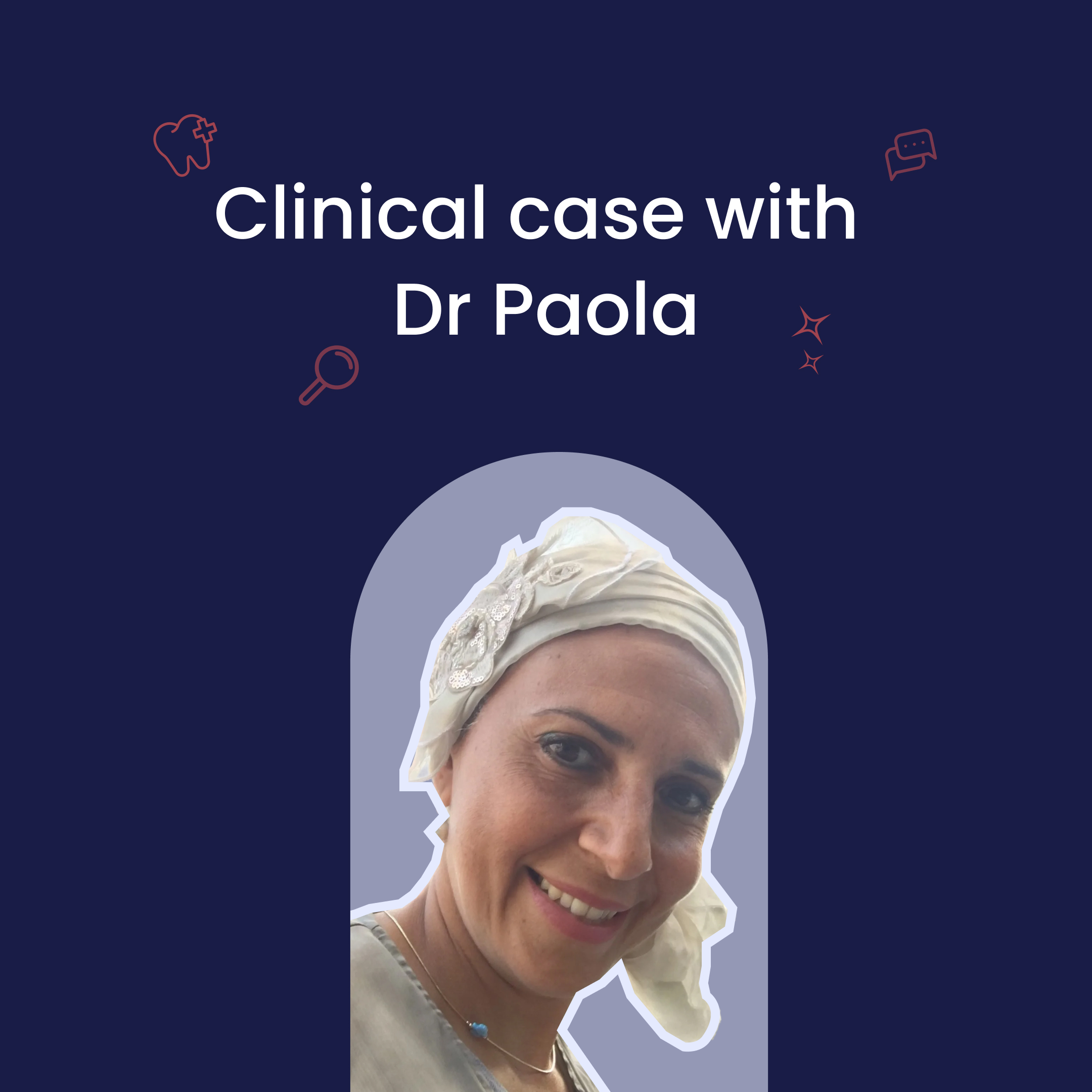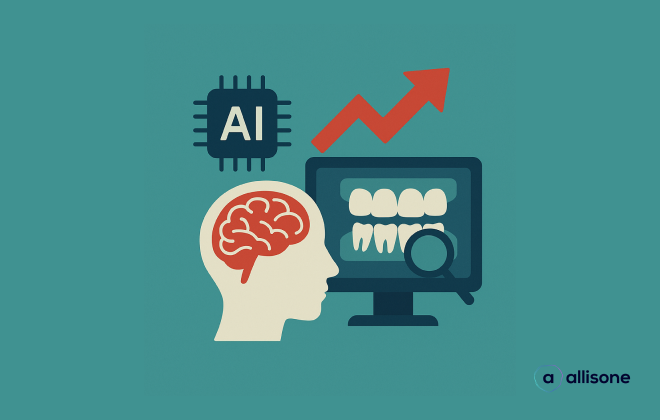
The adoption ofAllisone in dental practices reflects practitioners' focus on constantly improving patient experience, awareness and oral prevention. Thanks to artificial intelligence, our platform enriches the daily practice of dental surgeons, enabling clearer diagnoses and better interaction with patients.
To illustrate its many uses in practice, we met with one ofAllisone's users, Dr Aurélien. A graduate of the University of Brest and general practitioner for 9 years, he has completed his training in periodontology and implantology, and obtained a CES in prosthetics in Nantes, as well as a DU in aesthetics and optics in Brest. Although he works in a high-demand region, he remains firmly committed to putting patients first, and strives to offer comprehensive treatment plans for long-lasting care that is as closely aligned as possible with his patients' needs and requirements.
To find out how he integrates and applies Allisone to his day-to-day practice, we had the pleasure of talking to Dr. Aurélien.
Why did you decide to integrate Allisone into your practice?
The clear and accessible transmission of information is a fundamental part of my philosophy of care. I take it to heart to devote time to each patient, explaining in detail the ins and outs of their oral health situation. This transparent, layman's approach enables each patient to fully understand what's at stake, and to play an active part in treatment decisions. During a first appointment, I systematically set aside at least 40 minutes for diagnosis. This in-depth approach enables me to draw up a precise assessment of the patient's oral health, taking into account their functional and aesthetic needs, as well as their masticatory coefficient. Listening attentively to the patient is an essential pillar of my practice. I believe it's vital to respect each individual's pace and preferences when it comes to information. That's why I always ask the patient's permission before examining, showing or explaining anything in detail. Some patients prefer to discover their situation gradually, which I fully respect. The extensive use of photographs and the joint examination of the mouth using a mirror promote understanding and informed decision-making. To reinforce this transparency, I chose to integrate Allisone to enhance this visualization and the automatic generation of personalized documents to provide my patients with a detailed account of their consultation. This document, which includes a captioned panoramic X-ray, is similar to those issued by radiologists. In addition to its medico-legal importance, this approach contributes to enhancing the patient experience by providing a tangible record of their consultation.
The Allisone software is proving invaluable in implementing this patient-centered approach. Working in tandem with Allisone, I strive to offer each patient a positive and enriching dental experience.
Can you tell us about a clinical case where the use ofAllisone has been particularly beneficial?
Typical cases encountered in my practice include patients over 70 years of age who consult me to search for infectious foci, often in preparation for orthopedic surgery. Referred by their surgeon, these patients request a certificate attesting to the absence of oral pathology likely to compromise the success of the planned operation. My task with these patients is to detect any asymptomatic infectious foci that could complicate the planned surgery. This preventive approach is in line with our legal obligation to be transparent and to provide clear explanations of the diagnoses made.
Sometimes asymptomatic, these patients come to our clinics overconfident in their oral health, their absence of pain leading them to downplay the importance of a thorough examination. Their main concern is to quickly obtain the medical certificate required for orthopedic surgery.
My aim is to make the patient aware of the importance of preoperative oral care, even in the absence of obvious symptoms. In this context, Allisone proves invaluable. This clear, tangible representation of the patient's oral condition, even in the absence of immediate pain, helps to reinforce awareness and adherence to the proposed treatment. Allisone 's ability to make things visible on the X-ray plays a crucial role in educating patients about their oral health. This pedagogical approach transforms the patient's perception of the care provided and reinforces his or her commitment to the therapeutic process. Beyond its informative and educational dimension, the tool developed by Allisone provides patients with a feeling of serenity and reinforced confidence.
At what level does it bring serenity?
The patient's peace of mind is inextricably linked to our ability to be precise and clear in our explanations. This transparent approach with Allisone reinforces our credibility in the eyes of the patient, fostering a relationship of mutual trust. I'm firmly convinced that trust is the cornerstone of a successful practitioner-patient relationship, and that it must be earned and deserved. To access care, the patient must perceive the practitioner as transparent, trustworthy and competent.
In this process, Allisone proves to be an invaluable confidence-builder in establishing this relationship. By enabling improved visualization of panoramic X-rays and clear explanation of infectious foci, it helps to demonstrate to patients our deep understanding of their situation and our commitment to making informed decisions. Patient confidence also depends on scrupulous respect for informed consent. All too often neglected, this fundamental aspect of the patient-practitioner relationship is of the utmost importance. It involves asking the patient's permission before every stage of diagnosis and treatment, even if this may seem excessive at times. Obtaining these clear permissions undeniably reinforces trust and helps establish a serene and constructive therapeutic relationship.
What next for this clinical case?
This will vary from patient to patient, of course, but in this case it may be necessary to propose periodontal treatments to reduce the bacterial load and stabilize the situation. Targeted care may be needed for infected areas, endodontic removals and, in some cases, extractions may be considered if infections are severe. Depending on what's needed, we may also need to carry out additional examinations in addition to the panoramic X-ray, such as retroalveolar X-rays or cone beams to deepen the diagnosis. I can also call the orthopedic surgeon if necessary.
Do you see a significant difference for the patient when he can visualize his problems on a color-coded X-ray, even if he doesn't feel any pain?
Absolutely. The explicit visualization of problem areas at Allisone brings about a radical change in the patient's perspective. The clear representation of lesions, such as potential cavities or affected teeth, enables them to better understand the need for treatment, even in the absence of obvious symptoms.
In concrete terms, during the consultation, once I have obtained the patient's authorization, I announce my intention to show him the problem areas, specifying the tool to be used, Allisone, and the nature of the information to be uncovered. This approach encourages the patient to take ownership of the information, and allows him or her to express any questions or concerns freely. Once the patient has had time to assimilate the visual information, I intervene to provide a detailed explanation. I take care not to overload the patient with information, presenting elements progressively and clearly.
Do you useAllisone to simulate procedures or treatment plans, such as implant positioning?
I regularly use the treatment plan projection, which enables me to project the "post-care" x-ray and is very useful for procedures involving implants, for example. It allows you to visualize the locations of the sinuses and mandibular nerve, to envision the treatment plan, to predict the results and to discuss the options with the patient. It helps them visualize what the treatment will be like and understand the steps involved. It's also very useful for showing peri-apical lesions, and anything to do with veneers, crowns or bridges, while still clearly displaying the difference between composites and amalgams, for example.
How do you see the use of artificial intelligence evolving in your practice?
The advent of artificial intelligence, such asAllisone, opens up promising prospects for improving diagnostic explanations and boosting patient confidence. AI makes it possible to analyze complex data with greater precision, generate clear visualizations and provide relevant information in a matter of seconds, thus contributing to a better understanding of therapeutic issues.
However, it is vital to bear in mind that, on the one hand, clinical diagnosis takes precedence over radiological diagnosis, and therefore the practitioner is responsible, and, on the other, that the AI is not infallible and may occasionally make mistakes. The practitioner remains indispensable for verifying and validating the information provided by the AI, drawing on his or her expertise and clinical experience.
Articles en lien
Lorem ipsum dolor sit amet, consectetur adipiscing elit.

L’intelligence artificielle au cœur des soins dentaires : témoignage du Dr Paola

Mieux faire accepter les plans de traitement : 4 leviers qui fonctionnent vraiment






